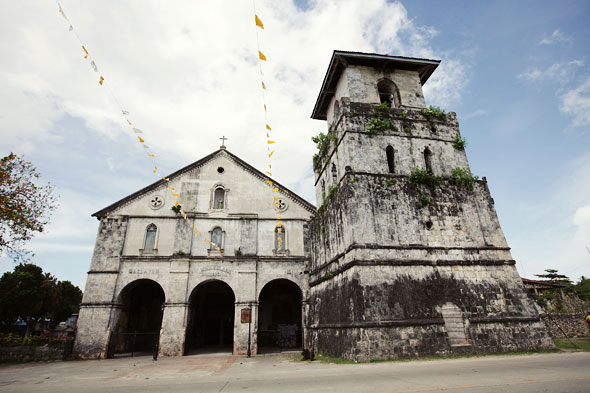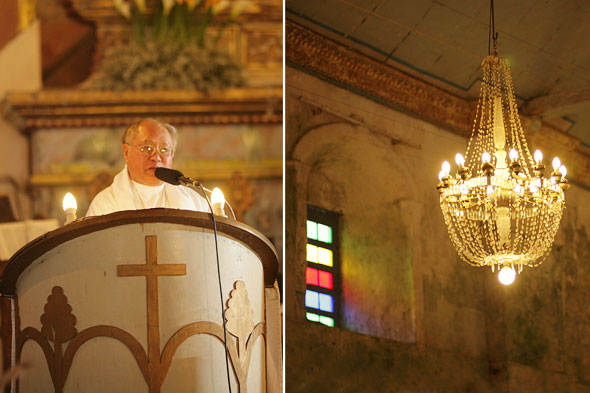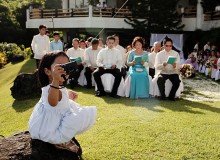The Historical Charm of Old Baclayon Church
Bohol with its natural sights and adventure sites is also rich in history. Who would have thought that the country’s tenth largest island with its kind and friendly people is also famous for holding the longest revolt in Philippine history, when Francisco Dagohoy led an 85-year rebellion against the Spaniards?
But the link between Bohol and history is none more obvious than in the numerous old churches (32 of them) dotting the island. The oldest, Baclayon Church, is central of them all, situated along the main highway, six kilometers away from the provincial capital of Tagbilaran City. It’s hard to miss, with its massive frame visible over the trees and houses approaching it.
Baclayon Church was built in 1595 and, next to Intramuros’ San Agustin Church which was built in 1571, is regarded as the second oldest stone church in the country. It was originally built by Spanish Jesuit missionaries, who first settled in Baclayon before moving their headquarters to Loboc town which they considered safer from Moro pirates.
The church as it stands today was first constructed in 1717, when Baclayon was elevated to the status of a parish and Jesuits thought it safer from Moros. Native slaves used coral stones from the sea for the structure, moving their heavy weights around with bamboo poles, and cementing them together with a million egg whites mixed with sand. What happened to the egg yolks is part of culinary history – they were used for pastries.
It took more than 200 of these slaves ten years to complete the construction, and more than a century later, a pipe organ was built (1824) and a large bell was installed (1835). A jail was also built inside the church compound to punish those who violated Roman Catholic laws. Like other Jesuit churches in the country, though, the Augustinian Recollects took over when the Jesuits were expelled from the Philippines, and additional buildings were constructed around the church. Today, another building stands perpendicular to the church – the old convent, which also houses a small museum that contains religious relics and other antique items, mute witnesses to the country’s rich history, religious or otherwise, for the past 400 years. These artifacts, though, have been a lure to burglars, especially the images which are mostly made from ivory, and with their adornments in gold threads and diamond-laden jewelry. The museum started the trend in having parish museums, and a visit to the one in Baclayon is worthwhile as one takes in the numerous precious material contained there.
The church shows combinations of what the Jesuits and the Recollects had built. The three arches of the portico or façade, like the museum, are credited to the Recollects. The Jesuits built the watch tower, perfect for the church as it stands watch over the Mindanao Sea. Baclayon Church is reputably one of the best preserved Jesuit-built churches in the entire Central Visayas. Recently, the 185-year old pipe organ, which is touted to be the third oldest in the Philippines, was restored through the initiative of the Zobel de Ayala family who appreciated the history of the Philippines through Baclayon. The restoration was painstakingly undertaken in Manila by European-trained pipe organ specialists. Having not been played for over 60 years, the return of the pipe organ was celebrated in 2008 with a concert featuring various classical European and Filipino classical music. The concert was held on December 6, just two days away from the feast of the church’s patroness, Our Lady of the Immaculate Concepcion.
Realizing this background, one can understand why the Baclayon Church would be an interesting site for a destination wedding. The wedding party would surely sense the charm of its history as they march down several meters of an aisle of gilded Mexican tiles leading up to the grand altar, lit by chandeliers. The church features an original pulpit, with a canopy shaped like the Virgin’s crown, as well as frescoes, and stained glass windows. A magnificent backdrop, too, would be the grand altar featuring seven figures in neo-classical design.
The church compound is spacious, and provides ample parking space as well as photo ops with the church and its coral-stone walls as background. Across the road is a small tree-filled plaza, and a pier that leads to a lighthouse, all providing a fantastic view of calm Mindanao Sea with Pamilacan Island and Siquijor province outlined in the distance. More wonderful settings for those romantic photo ops!
For the wedding reception, the whole entourage and their guests can make their bookings in any of several establishments in Tagbilaran City, which is less than a 15-minute drive, or in one of the resorts of Panglao Island, which is less than 30 minutes away. For those whose budget can afford it, there is also the highly opulent and exclusive Peacock Garden resort, a few minutes’ drive away into a more interior area of Baclayon.
Pamilacan Island, a barangay of Baclayon, can also provide an alternative honeymoon site for the more adventurous and laid-back couple. All they need to do is arrange, with one of the offices near the church, for an overnight stay in simple amenities (a small hut, and limited freshwater supply), basking in the island’s unspoiled fine white sand beach after engaging in dolphin and whale-watching, which the island is known for.
















Kylee Jensen
December 4, 2012 @ 3:10 am
What is the rate to have a wedding ceremony at the Baclayon Church?
Thanks!
Mimi and Karl – Real and Heartfelt Wedding Photographers » Blog Archive » Patrick + Avry (Baclayon Church | Panglao Island Nature Resort Bohol)
December 11, 2012 @ 10:06 pm
[…] her future — her moving to another country after graduation. At the last church she visited, Baclayon Church, she prayed that if she was lucky enough to find a partner in life, she promised to return to Bohol […]
Travel | Chocolate Hills | Bohol Engagement & Wedding Photographer
November 2, 2013 @ 12:34 pm
[…] The second oldest church in the Philippines. […]